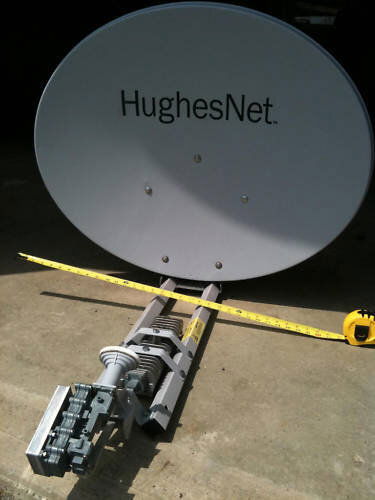Hi everyone, I just got a hughesnet dish it measures 28 3/4" X 34"
and I cant get anything on it. I have been reading a lot about FTA here for the last few weeks so am familiar with basic setup, elevation, azimuth etc...
I'm using a coolsat 5000 and would like to get Galaxy 19 for starters.
Perhaps the dish is to small for Salem Oregon? I am very frustrated been trying for a couple weeks now, even tried a spitfire elite Lnb with no results.
Funny thing there is a di*h network dish 500 fully setup when I moved here just couple feet away from my new install and the coolsat scans 119 well, all scrambled but well So I'm thinking looks clear from around 90 to 190 degrees (magnetic)
So I'm thinking looks clear from around 90 to 190 degrees (magnetic)
So I move my hughesnet dish 20 degrees east or so and nothing, heck tried 123.0 W today still no go. Any clues? I'm at loss. One last thing hughesnet dish was set at around 22 degrees elevation by a former hughsnet installer, wonder why so low?
P.S I included a pic of the same model dish as mine.
Sorry about the lengthy post but Thanks in advance to all.
and I cant get anything on it. I have been reading a lot about FTA here for the last few weeks so am familiar with basic setup, elevation, azimuth etc...
I'm using a coolsat 5000 and would like to get Galaxy 19 for starters.
Perhaps the dish is to small for Salem Oregon? I am very frustrated been trying for a couple weeks now, even tried a spitfire elite Lnb with no results.
Funny thing there is a di*h network dish 500 fully setup when I moved here just couple feet away from my new install and the coolsat scans 119 well, all scrambled but well
So I move my hughesnet dish 20 degrees east or so and nothing, heck tried 123.0 W today still no go. Any clues? I'm at loss. One last thing hughesnet dish was set at around 22 degrees elevation by a former hughsnet installer, wonder why so low?
P.S I included a pic of the same model dish as mine.
Sorry about the lengthy post but Thanks in advance to all.



 to the forum
to the forum